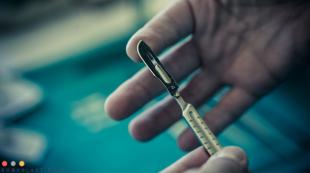Christmas star from the past on LEDs. With such a LED star you can please your loved ones at any holiday New Year's star from the past on LEDs
That same time has come, the end of the year, snow, holidays and good mood)) And what (New Year / Christmas) holiday without a Christmas tree? And what is a Christmas tree without decorations? It is about decoration that will be discussed, or rather about final touch, so to speak about the cherry on the cake, more precisely about the star on the Christmas tree. In general, you are welcome under CUT.
Actually, an asterisk for a Christmas tree was ordered from the Chinese. In the lot there is a choice of sizes, everything is like in Soviet times: I ordered item No. 1 No. 2 No. 3 No. 2. The size from the tip to the tip of the star is 18cm.  The star is made of transparent brittle plastic, on the surface there are many facets for light refraction.
The star is made of transparent brittle plastic, on the surface there are many facets for light refraction.  Actually, everything is simple: two identical halves, a core with electronics, a leg-mount for the top and a switch.
Actually, everything is simple: two identical halves, a core with electronics, a leg-mount for the top and a switch.  This is what it looks like when enabled.
This is what it looks like when enabled.
Here it would be possible to complete the review, but it’s so easy, dear reader, you can’t get off)))
I decided that I want the best and I know how to get it from this simple piece of plastic. Yes, yes, the WS2812B solution is quite predictable - simple and beautiful, but here I have my own approach.
1) I will not use arduino or ESP.
2) I do not need any IR receivers, WIFI or Bluetooth, I am not going to sit under the tree and switch colors, this is the task of the software.
3) The device will be made on one board, and not from shit and sticks of different modules of wires and hot melt adhesive.
4) I will use PIC18F46J50 and write all the code in mikroC myself.
In general, such an old-school approach)))
First of all, we measure the star and create a board in Altium. 
More developments here
After fitting paper version boards, you can begin to create a real board from foil textolite. We take out a piece from the stash and cut the workpiece to fit.  A film photoresist will be used and for successful “rolling” it is necessary to clean the contaminated surface. (Water rolling off the board is a sign of contamination)
A film photoresist will be used and for successful “rolling” it is necessary to clean the contaminated surface. (Water rolling off the board is a sign of contamination)  We take a dish sponge and clean it with an abrasive part, in addition, you can use an acid cleaner (for example, a toilet bowl cleaner).
We take a dish sponge and clean it with an abrasive part, in addition, you can use an acid cleaner (for example, a toilet bowl cleaner).  The main thing is to achieve the result, and the method by which it was obtained is not very important to us. Success is the surface that is wetted with water.
The main thing is to achieve the result, and the method by which it was obtained is not very important to us. Success is the surface that is wetted with water.  Now you can start fitting the pre-prepared photomasks. (They are printed on a transparent film, solvent vapors and a double layer of templates can be used to increase the density)
Now you can start fitting the pre-prepared photomasks. (They are printed on a transparent film, solvent vapors and a double layer of templates can be used to increase the density)  We “roll” the photoresist, there are many different ways. I wet the workpiece, put the prepared piece of film, level it and drive out the water with a silicone spatula. Then I put the workpiece between two sheets of paper and send it to the laminator. (I want to note that there are many ways to perform this procedure)
We “roll” the photoresist, there are many different ways. I wet the workpiece, put the prepared piece of film, level it and drive out the water with a silicone spatula. Then I put the workpiece between two sheets of paper and send it to the laminator. (I want to note that there are many ways to perform this procedure)  We install the sheet between the templates, making sure that the placement is correct.
We install the sheet between the templates, making sure that the placement is correct.  It's time for the exposure.
It's time for the exposure.  After a certain time (individually for each type of lamp photoresist and distances), we don’t seem to see the result, but if you look closely, there are changes.
After a certain time (individually for each type of lamp photoresist and distances), we don’t seem to see the result, but if you look closely, there are changes.  It remains to carefully, like an archaeologist with a brush, show these changes in a solution of weak alkali (soda ash).
It remains to carefully, like an archaeologist with a brush, show these changes in a solution of weak alkali (soda ash).  After washing, we get a mask, open areas of copper will be removed at the next stage of “etching”, so you need to carefully examine the mask and remove the “jambs”
After washing, we get a mask, open areas of copper will be removed at the next stage of “etching”, so you need to carefully examine the mask and remove the “jambs”  After etching, we get an almost finished board.
After etching, we get an almost finished board.  Next, use a solvent or strong alkali (clog cleaner) to remove the photoresist. Caution When working with alkali, use goggles and gloves to avoid chemical burns and permanent damage to eyesight.
Next, use a solvent or strong alkali (clog cleaner) to remove the photoresist. Caution When working with alkali, use goggles and gloves to avoid chemical burns and permanent damage to eyesight.  Now slowly you can see the result of the time spent.
Now slowly you can see the result of the time spent.  We cut off everything superfluous, and try on the board for the future place.
We cut off everything superfluous, and try on the board for the future place.  We drill holes.
We drill holes.  Next, I decided to tin the board (of course, the solder is not chrome, but the metallic sheen will come in handy for me)
Next, I decided to tin the board (of course, the solder is not chrome, but the metallic sheen will come in handy for me)  After tinning and cleaning the board, we assemble.
After tinning and cleaning the board, we assemble.  Next, connect the PSU (There was a jamb with it, the Chinese raised the voltage to 5.4, we had to lower it a little by changing the values of the setting resistors to TL431)
Next, connect the PSU (There was a jamb with it, the Chinese raised the voltage to 5.4, we had to lower it a little by changing the values of the setting resistors to TL431)
After all the agony of bingo. 
Now it remains to write the program.
The requirements are simple, many effects and the randomness of their choice. To control the LEDs, I used SPI in more detail under the spoiler.
Briefly about programming
If you look at the description, then to control the ws2812B, signals of the same period are used, but of different durations of the level of the logical unit "1" and zero "0", it is worth noting that the control signals are quite fast with tolerances of 150ns.  However, there is one feature, ws2812b is not very demanding on compliance with these tolerances and only the duration is critical high level, a low level can seriously deviate from the specified requirements. This allows you to use SPI to send data. If you set the correct SPI frequency, you can send two signal bits in one byte, which I actually used.
However, there is one feature, ws2812b is not very demanding on compliance with these tolerances and only the duration is critical high level, a low level can seriously deviate from the specified requirements. This allows you to use SPI to send data. If you set the correct SPI frequency, you can send two signal bits in one byte, which I actually used.  In my design, there are 2 sides (they are parallel), on each side there are 15 LEDs in series, knowing that each ws2812b has 3 bytes for color encoding (this is 12 bytes via SPI), we get that everything needs 180 bytes of RAM (“video memory "). Therefore, to output colors, you need to create an array of 180 bytes, change the values to create a picture and send these 180 bytes over SPI.
In my design, there are 2 sides (they are parallel), on each side there are 15 LEDs in series, knowing that each ws2812b has 3 bytes for color encoding (this is 12 bytes via SPI), we get that everything needs 180 bytes of RAM (“video memory "). Therefore, to output colors, you need to create an array of 180 bytes, change the values to create a picture and send these 180 bytes over SPI.
After we figured out how to manage, we configure the microcontroller and write several functions
Star update - output "video memory"
Setting the color of a specific pixel (for convenience, I introduced a star-ring and ray coordinate system)
Pixel color copy
Setting the color of all memory,
Beam color setting
Ring color setting
beam rotation,
"Retraction" and "repulsion" of the rings relative to the center of the star.
These 8 functions allow you to create various effects. Using randomness and mathematics, I created 15 different modes. To randomly generate effects and select a sequence of effects, I used pseudo-random (random number generation), to avoid repetition when you turn it on again, you can set the starting point of generation for these purposes I used the sum of video memory cells immediately after the start of the microcontroller, when it contains various arbitrary information.
In the end, here's what I got. (here I turn the stars on and off to show the modes)
Well, perhaps you can bow out on this, I hope you dear reader liked the review. And for dessert, a festive gif)

circuit diagram a simple flasher for switching nine lines with LEDs, built on the K561IE8 counter. Traditionally, the top of the Christmas tree is crowned with a star. In Soviet times, the star was red, now it may be "cosmic" of blue color or transparent. Usually the star is illuminated by one of the bulbs of the garland system.
But, using modern super bright LEDs of blue or white color, and a simple scheme on a decimal counter, you can make it so that the star will shine with rays - bright blue or white lights from the center of the star will scatter to the ends of its rays, go out, and again born in the center scatter to the ends of the rays. In the dark, using blue or white super bright LEDs, the effect is quite impressive.
circuit diagram
The circuit is very simple, it consists of a clock source on a blinking HL45 LED, which, by the way, can be mounted in the center of the star, or, if this is not necessary, left inside. If the light from the HL45 is not needed, you can increase the resistance R1 to several tens of kiloohms, while the LED glow will be minimal, and as a pulse generator it will continue to work.
In addition, the components of the circuit are a binary-decimal counter D1 and nine transistor switches VT1-VT9, each of which is loaded with five LEDs connected in series. It uses LEDs of the AL-513B1C type, these are super bright blue LEDs with a diameter of 5 mm. The forward voltage of each of them is 3.6V, that is, five pieces take 18V. Therefore, in order to ensure the operation of the LEDs (the required current), the supply voltage of the LED circuits must be at least 20V.
Well, no more than 30V. The current through them is limited by resistors R12-R20. The number of LEDs, equal to five, in each circuit is due to the fact that the star is five-pointed (one LED from each circuit to each ray of the star). If your star with a different number of rays, for example, six-pointed, then there will be six LEDs in each circuit.
Rice. 1. Schematic diagram of the LED flasher for the New Year's star.
During the operation of the meter, the LED circuits are sequentially switched. First, HL1-HL5, located closest to the center of the star, burn, then they go out and light up HL6-HL10, located a little further along the rays from the center of the star, then HL11-HL15, and so on.
The process ends with HL40-HL44 LEDs, which are located at the very tips of the rays of the star. Thus, the effect of luminous points is visually obtained, scattering from the center of the star along its rays.
The speed of this process depends on the blinking frequency of the HL45 LED, and averages 2 Hz. If you need a different speed, you need to supplement the circuit with a multivibrator, which will generate pulses input to the counter D1.
By selecting the parameters of the RC circuit of this multivibrator, it will be possible to adjust the playback speed of the effect. And so, the speed is not regulated.
Details
In this device, all LEDs can be replaced by any analogues and not quite analogues. In place of the HL45 there should be any flashing single color indicator LED. In place of HL1-HL44, - any LEDs, any color (as they say, a matter of taste).
Of course, the color of the LEDs must somehow be in harmony with the color of the star.
Antyukhov V. V. RK-2015-11.
So, we begin our New Year's serpentine. I think that the topic is very relevant - to make the top for the Christmas tree with your own hands!
The article presents 2 design options - on SMD and conventional LEDs. Based on the design "LED garland on MK Attiny13".

Asterisks - used Chinese transparent tops. I added transistors to increase the number of LEDs. There are three print options in the files.
According to the scheme: instead of LEDs through a 1kΩ resistor to the base of the NPN BC547 transistor, then the LEDs are simply in parallel. Current-limiting resistance - 47 Ohm. The fill is used as a plus and not a minus as we are usually used to (I don’t know why it happened, well, how it happened). In the archive of materials there is a third design option, double-sided, for two-color LEDs. Just made the transition to the other side and added four more LEDs for each beam. In total, 8 LEDs per transistor are obtained. When I made the board in DIP packages, I sawed grooves under the LEDs and they illuminate both sides of the star. And then the idea arose not to cut the grooves, but to make two sides of a different color. If you put it on a rotating Christmas tree, or just hang it on wires, it will turn towards the viewer different colors. In iron it is not checked up yet.



details:
The administrator of the portal has already ordered SMD LEDs several times here, the seller sends literally on the same day.
The proposed scheme works as a generator of simple lighting effects on LEDs.
The LEDs are arranged in the form of eight rays of a star, as you can see by looking at the figure. printed circuit board.
This design is an ideal decoration for a Christmas tree or a decorative element of a home interior.
The first LED is the center. Then come the LEDs of the inner ring (D3-D19), then the next ring, and so on, all the way to the outer ring (D43-D50). Then everything repeats again. The switching speed depends on the parameter of the variable resistor P1.
The clock generator is assembled on the 555 timer (IC1), then the clock frequency is fed to the 4017 decimal counter (IC2). a signal appears in series on pins 0-6, which controls the LEDs using buffer transistors (T1-T7). The seventh clock pulse resets the counter and everything repeats.
Rice. 1.Christmas tree star switch circuit
List of components:
Resistors:R1 = 2 kOhm
R2 = 10 kOhm
R3 = 33 kOhm
R4 = 390 Ohm
R5, R6, R9, R12, R15, R18, R21 = 1 kOhm
R7,R8,R10,R11,R13,R14,R16,R17,R19,R20,R22,R23 = 100 ohm
P1 = 25 kΩ AC
Capacitors:
C1,C3,C4 = 0.1uF
C2 = 2.2uF 16V electrolyte
Semiconductors:
D1=1N4148
D2-D50 = red LEDs
T1-T7=BC547
IC1 = 555
IC2 = 4017
Source of power:
krone battery or any other 9V cell battery

Rice. 2. Arrangement of elements



This is a small guide on how to make the stars sparkle. In this way, you can create a Christmas tree without logging in the forest. Here are the Christmas trees:
Can't watch video Click here...
A little soldering and you can make some pretty LED stars. The size can be 6 - 10 cm wide, and a 9-volt battery will be supplied.
If you want to be able to easily change batteries, see Step 5. The star can be mounted on a 9-volt battery clip ...
Take your soldering iron, LEDs, find some batteries and make bright Christmas decorations out of it.
If suddenly you are not sure of your soldering talent, start with a simple one - a star. It's really easy and you can handle it for sure. Believe me.
Step 1: Materials and Tools



For the Christmas LED star you will need:
5 red 5mm or 10mm LEDs: the choice is yours. The bulbs need to be red in order to shine well enough from a 9-volt battery. I tried both conventional diodes and matte ones. Choose what you like best
- 9 volt battery.
- 10 cm of strong copper wire.
If you want to make a *blinking* diode star, you will need different types LEDs:
1 flashing diode 5 mm red.
- 4 “low current” LEDs with a transparent bulb, also red.
The total cost of one twinkling star is about 90 rubles, depending on where you bought the diodes. An ordinary asterisk will cost 30 rubles cheaper.
Tools you will need:
- for the template: 5 mm plywood or something similar.
- soldering iron and solder
- pliers and pincers
- polymer clay or a third hand to secure parts of the star for soldering
- multimeter for debugging
Step 2: Layout

Christmas diode star:
The circuit for the LED star is not very complicated. Five diodes are connected "head to tail" in one circuit.
The circuit breaker is not a physical part of the star. The asterisk lights up (the circuit is closed) when the wire is connected to the positive terminal of the battery.
Step 3: Making a Diode Star




To make soldering the diodes as easy as possible, I made a template out of plywood. This is a circle with marks for five light bulbs.
- Place the diodes on the template.
- Spread the legs of the diodes at an angle so that they coincide with the sides of the star and adjacent legs of different diodes intersect with each other.
- Fix the diode contacts on the template.
- Solder the pin connections
- Cut off excess edges with small pliers.
You have a closed star.
- Cut off the worst solder joint.
- Now you have a star with a cut.
Check circuit operation:
Connect the ends of the star to the battery terminals. Don't forget about the polarity of the diodes and the battery! If the asterisk is on, you did everything right. If not:
- most likely, you have connected at least one diode head-to-head instead of head-to-tail.
- If all the diodes are soldered correctly and STILL does not work (this happened to me ...), most likely one of the diodes is not working. Test each diode individually with a multimeter or 3V button cell or power supply.
Solder a piece of copper wire (about 4 cm) to the negative terminal of the diode circuit. Figure 3 shows this step.

Step 4: The final stage





You almost made it! It remains only to solder a piece of wire to the negative pole of the battery.
There are a couple of features here:
- Take a piece of wire, the same length as the one you just soldered to the star.
- Put the battery down and attach the wire to the larger battery terminal (marked with a minus sign).
- To solder a wire to a pin, make sure both wire and pin are warm before adding solder.
HINT:
First fix the position of the battery and wire. Use duct tape, a third hand, or whatever to secure the battery and wire before soldering.
Finally, solder the other end of the wire to the positive terminal of the diode star. Now everything is ready :-D
Liked? In the same way, you can make a Christmas tree. It requires a little more effort and patience, but the result will justify these difficulties! If you mastered the asterisk, the Christmas tree is simply bound to turn out!
Step 5: Adding a Battery Clip...









